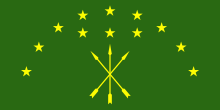
Back الشتات الشركسي Arabic ჩერქეზული დიასპორა Georgian Адыгская диаспора Russian Адизька діаспора Ukrainian
 | |
 Map of the Circassian diaspora | |
| Total population | |
| c. 5.3 million | |
| Regions with significant populations | |
| 2,000,000–3,000,000[1][2][3] | |
| 751,487[4] | |
| 500,000[5][3] | |
| 80,000–120,000[3][6][7][8][9] | |
| 50,000[citation needed] | |
| 40,000[3][10] | |
| 35,000[11] | |
| 34,000[12] | |
| 25,000[12][better source needed] | |
| 23,000[citation needed] | |
| 5,000–50,000[13] | |
| 4,000–5,000[14][15][16] | |
| 1,257[17] | |
| 1,001[18] | |
| 1,000[19][20][21] | |
| 500[22] | |
| 400[23] | |
| 116[24] | |
| Languages | |
| Native: West Circassian, East Circassian Diaspora: Turkish, Russian, Arabic, English, German, Persian, Hebrew | |
| Religion | |
| Majority: Sunni Islam[13]
Minority: Christianity (mostly Eastern Orthodoxy, but also Catholicism),[25] Circassian paganism,[26] irreligion[27] | |
| Related ethnic groups | |
| Abazgi peoples (Abkhaz, Abazin), Chechens | |
| Part of a series on the |
| Circassians Адыгэхэр |
|---|
 List of notable Circassians Circassian genocide |
| Circassian diaspora |
| Circassian tribes |
|
Surviving Destroyed or barely existing |
| Religion |
|
Religion in Circassia |
| Languages and dialects |
|
| History |
|
Show |
| Culture |
The Circassian diaspora are ethnic Circassians around the world who were driven from Circassia during the late nineteenth and early twentieth century. From 1763 to 1864, the Circassians fought against the Russian Empire in the Russian-Circassian War which ended in a genocide campaign initiated between 1862 and 1864.[28][29]Large numbers of Circassians were exiled and deported to the Ottoman Empire and nearby regions; others were resettled in Russia far from their homeland.[30][31] Circassians live in more than fifty countries, besides the Republic of Adygea.[32] Total population estimates differ: according to some sources, some two million Circassians live in Turkey, Jordan, Syria, and Iraq;[33] other sources say between one and four million live in Turkey alone.[34]
- ^ Richmond, Walter (2013). The Circassian Genocide. Rutgers University Press. p. 130. ISBN 978-0813560694.
- ^ Danver, Steven L. (2015). Native Peoples of the World: An Encyclopedia of Groups, Cultures and Contemporary Issues. Routledge. p. 528. ISBN 978-1317464006.
- ^ a b c d Zhemukhov, Sufian (2008). "Circassian World Responses to the New Challenges" (PDF). PONARS Eurasia Policy Memo No. 54: 2. Retrieved 8 May 2016.
- ^ "Национальный состав населения". Federal State Statistics Service. Retrieved 30 December 2022.
- ^ "Израйльский сайт ИзРус". Archived from the original on 30 October 2013. Retrieved 8 April 2013.
- ^ "Syrian Circassians returning to Russia's Caucasus region". TRTWorld. TRTWorld and agencies. 2015. Archived from the original on 1 June 2016. Retrieved 8 May 2016.
Currently, approximately 80,000 ethnic Circassians live in Syria after their ancestors were forced out of the northern Caucasus by Russians between 1863 and 1867.
- ^ "Syria" Archived 11 May 2011 at the Wayback Machine Library of Congress
- ^ "Независимые английские исследования". Archived from the original on 8 May 2013. Retrieved 8 April 2013.
- ^ "single | The Jamestown Foundation". Jamestown. Jamestown.org. 7 May 2013. Retrieved 20 August 2013.
- ^ Lopes, Tiago André Ferreira. "The Offspring of the Arab Spring" (PDF). Strategic Outlook. Observatory for Human Security (OSH). Archived from the original (PDF) on 24 December 2018. Retrieved 16 June 2013.
- ^ "Via Jamestown Foundation". Jamestown. Archived from the original on 10 September 2012. Retrieved 8 April 2013.
- ^ a b "Adyghe by country". Archived from the original on 21 October 2013. Retrieved 8 April 2013.
- ^ a b "Circassians in Iran". Caucasus Times. 9 February 2018.
- ^ Besleney, Zeynel Abidin (2014). The Circassian Diaspora in Turkey: A Political History. Routledge. p. 96. ISBN 978-1317910046.
- ^ Torstrick, Rebecca L. (2004). Culture and Customs of Israel. Greenwood Publishing Group. p. 46. ISBN 978-0313320910.
- ^ Louër, Laurence (2007). To be an Arab in Israel. Columbia University Press. p. 20. ISBN 978-0231140683.
- ^ "Всесоюзная перепись населения 1989 года. Национальный состав населения по республикам СССР" (in Russian). Archived from the original on 6 January 2012. Retrieved 6 August 2019.
- ^ "The distribution of the population by nationality and mother tongue". 2001.ukrcensus.gov.ua. Retrieved 6 August 2019.
- ^ "Circassian Princes in Poland: The Five Princes, by Marcin Kruszynski". www.circassianworld.com. Archived from the original on 28 July 2020. Retrieved 29 January 2020.
- ^ "Polish-Circassian Relation in 19th Century, by Radosław Żurawski vel Grajewski". www.circassianworld.com. Archived from the original on 28 July 2020. Retrieved 29 January 2020.
- ^ "Polonya'daki Çerkes Prensler: Beş Prens". cherkessia.net. 26 December 2011. Retrieved 29 January 2020.
- ^ Zhemukhov, Sufian, Circassian World: Responses to the New Challenges, archived from the original on 12 October 2009
- ^ Hildebrandt, Amber (14 August 2012). "Russia's Sochi Olympics awakens Circassian anger". CBC News.
- ^ "Национальный статистический комитет Республики Беларусь" (PDF) (in Belarusian). Statistics of Belarus. Archived from the original (PDF) on 18 October 2013.
- ^ James Stuart Olson, ed. (1994). An Ethnohistorical dictionary of the Russian and Soviet empires. Greenwood. p. 329. ISBN 978-0-313-27497-8. Retrieved 15 October 2011.
- ^ 2012 Survey Maps Archived 20 March 2017 at the Wayback Machine. "Ogonek". No 34 (5243), 27 August 2012. Retrieved 24 September 2012.
- ^ Svetlana Lyagusheva (2005). "Islam and the Traditional Moral Code of Adyghes". Iran and the Caucasus. 9 (1): 29–35. doi:10.1163/1573384054068123. JSTOR 4030903 – via Brill.
in February 1996... Respondents in the 20–35 age group... 26 percent considered themselves atheists...
- ^ Allen and Muratoff 107–108.
- ^ Shawkat.
- ^ Brooks [page needed].
- ^ Shenfield. [page needed]
- ^ Richmond 2.
- ^ Richmond 172-73.
- ^ Stokes 152.